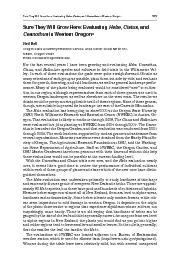/


575 ID: 823007
Download Pdf The PPT/PDF document "Sure They Will Grow Here: Evaluating , a..." is the property of its rightful owner. Permission is granted to download and print the materials on this web site for personal, non-commercial use only, and to display it on your personal computer provided you do not modify the materials and that you retain all copyright notices contained in the materials. By downloading content from our website, you accept the terms of this agreement.
575Sure They Will Grow Here: Evaluating
575Sure They Will Grow Here: Evaluating , and in Western OregonOregon State University Extension Service, 3180 Center Street NE #1361,Email: neil.bell@oregonstate.eduFor the last several years I have been growing and evaluating , and species and cultivars in �eld trials in the Willamette Valley. In each of these evaluations the goals were quite straightforward. Obtain as many selections of each group as possible, plant them out side-by-side, and evaluate them for growth, �owering, and cold hardiness, as well as general landscape performance. Many of the plants being evaluated would be consi
dered “new” to cultivation in
dered “new” to cultivation in our region, although representatives from each of these genera are used in western Oregon landscapes, as well as elsewhere on the west coast. The results we obtain would be pretty much applicable to all of these regions. None of these genera, evaluation has been going on since 2000 at the Oregon State Uiversity (OSU) North Willamette Research and Extension Center (NWREC) in Aurora, Oregon. That evaluation is likely to continue through 2008. The and were evaluated in a joint planting at NWREC from 2004 through 2007. The is located at the Oregon Garden, and that evaluation w
as conducted from 2001 through 2005. The
as conducted from 2001 through 2005. The work has been supported by modest grants and assistance from several organizations. Monetary assistance was obtained from the Hardy Plant Society of Oregon, The Agricultural Research Foundation at OSU, and the Washington State Department of Agriculture. Staff at NWREC, the Oregon Garden, and OSU Master Gardeners have been generous with their time and without this help With the and trials now over, and the evaluation nearly over, it seems like a good time to review the performance of individual cultivars within each of these groups of plants and share which of the new ones
have distinguished themselves. evaluat
have distinguished themselves. evaluation was undertaken primarily to study hardiness of this large and extremely diverse genus of evergreen New Zealand shrubs. There are approximately 80 species, but these have produced hundreds of cultivars and hybrids. Because hebes range over almost all of New Zealand, from sea level to alpine areas, hardiness varies dramatically. Some hebes tolerate only modest freezes, while others seem impervious to cold damage in western Oregon. It depends on the origin of the plant: those native to regions that experience signi�cant winter cold are, not surprisingly, more har
dy. There is an old saying that hardines
dy. There is an old saying that hardiness of hebes can be gauged by the size of the leaf and this is generally correct. As one goes from sea level to alpine regions in New Zealand, the plants you would �nd as you go into higher and colder regions tend to have smaller and smaller leaves. So the rule is, generally, The evaluations at NWREC are located adjacent to a Bureau of Reclamation weather station which is used for climate data (http://www.usbr.gov/pn/agrimet/). Winters during the trials have been relatively mild, but with several unexpected Sure They Will Grow Here: Evaluating , and in Western Orego